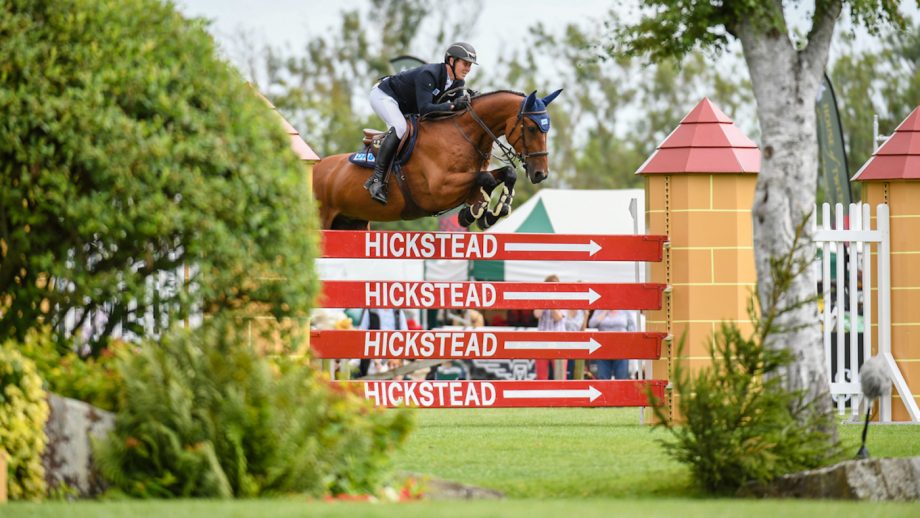What does it take to win as a working hunter at the Royal International Horse Show? Ahead of the 2021 show, H&H’s showing editor Alex Robinson speaks to those who know the track best...
ALL artists go into their projects with a vision, and for course-designer Kevin Millman, the grassy, undulating turf of ring five at Hickstead, home of the Prenetics Royal International Horse Show (RIHS), provides the perfect canvas.
“It’s a true hunting course over true hunting obstacles,” explains RIHS senior working hunter course-designer Kevin, who has been designing the track for some 20 years. “It’s a championship class so naturally we’re not expecting lots of clears, though this does depend on the judges; some will request a really tough course which will produce only one or two clears, while others will ask for more clean rounds so the show and conformation section has more weight.
“We walk the course together and the decision on the final course is ultimately down to them, at my discretion.”
{"content":"PHA+VGhlIDEyLWZlbmNlIGNvdXJzZSwgd2hpY2ggaXMgc2V0IG9uIGEgc2xvcGUgYW5kIHJlcXVpcmVzIDE1IHRvIDE2IGVmZm9ydHMgZnJvbSB0aGUgY29tYmluYXRpb25zLCBpcyBhIG1peCBvZiBzZXZlbiBwZXJtYW5lbnQgZmVuY2VzIOKAkyBpbmNsdWRpbmcgYSBDb3JuaXNoIHdhbGwsIGFuIG9wZW4gZGl0Y2ggYW5kIGEgaGVkZ2Ug4oCTIGFuZCBzb21lIHRlbXBvcmFyeSBjb25zdHJ1Y3Rpb25zLjwvcD4KPHA+V2hpbGUgS2V2aW4gc2F5cyB0aGUgY291cnNlIGlzIGFyZ3VhYmx5IG5vdCBhcyBzaXphYmxlIGFzIGl0IHdhcyAxNSB5ZWFycyBhZ28sIG1haW5seSBkdWUgdG8gaGVhbHRoLWFuZC1zYWZldHkgcmVndWxhdGlvbnMsIHF1ZXN0aW9ucyBhcmUgc3RpbGwgYXNrZWQgYW5kIHRoZSBuYXR1cmUgb2YgdGhlIGZlbmNlcyBjZXJ0YWlubHkgc2VwYXJhdGVzIHRoZSB3aGVhdCBmcm9tIHRoZSBjaGFmZi48L3A+CjxwPjxkaXYgY2xhc3M9ImFkLWNvbnRhaW5lciBhZC1jb250YWluZXItLW1vYmlsZSI+PGRpdiBpZD0icG9zdC1pbmxpbmUtMiIgY2xhc3M9ImlwYy1hZHZlcnQiPjwvZGl2PjwvZGl2PjxzZWN0aW9uIGlkPSJlbWJlZF9jb2RlLTMxIiBjbGFzcz0iaGlkZGVuLW1kIGhpZGRlbi1sZyBzLWNvbnRhaW5lciBzdGlja3ktYW5jaG9yIGhpZGUtd2lkZ2V0LXRpdGxlIHdpZGdldF9lbWJlZF9jb2RlIHByZW1pdW1faW5saW5lXzIiPjxzZWN0aW9uIGNsYXNzPSJzLWNvbnRhaW5lciBsaXN0aW5nLS1zaW5nbGUgbGlzdGluZy0tc2luZ2xlLXNoYXJldGhyb3VnaCBpbWFnZS1hc3BlY3QtbGFuZHNjYXBlIGRlZmF1bHQgc2hhcmV0aHJvdWdoLWFkIHNoYXJldGhyb3VnaC1hZC1oaWRkZW4iPg0KICA8ZGl2IGNsYXNzPSJzLWNvbnRhaW5lcl9faW5uZXIiPg0KICAgIDx1bD4NCiAgICAgIDxsaSBpZD0ibmF0aXZlLWNvbnRlbnQtbW9iaWxlIiBjbGFzcz0ibGlzdGluZy1pdGVtIj4NCiAgICAgIDwvbGk+DQogICAgPC91bD4NCiAgPC9kaXY+DQo8L3NlY3Rpb24+PC9zZWN0aW9uPjwvcD4KPHA+4oCcQ29tcGV0aXRvcnMgb2Z0ZW4gY29tZSBiYWNrIGFmdGVyIHRoZSBjbGFzcyBpbiB0aGUgZXZlbmluZyB0byBtZWFzdXJlIHNvbWUgb2YgdGhlIGZlbmNlcyBzbyB0aGV5IGNhbiBidWlsZCB0aGVtIGF0IGhvbWUs4oCdIHNheXMgS2V2aW4uIOKAnFRydWUgaHVudGVyIHR5cGVzIHRlbmQgdG8gZmFyZSBiZXR0ZXIsIGFuZCB3aGlsZSB0aGUgY291cnNlIGlzIGJ1aWx0IGZvcndhcmQgYW5kIHNvbWUgaG9yc2VzIGhhdmUgbm8gcHJvYmxlbSB3aXRoIHRoZSBwYWNlLCBpdOKAmXMgdGhlIHJlcXVpcmVkIHN0YW1pbmEgd2hpY2ggY2FuIGxldCB0aGVtIGRvd24uPC9wPgo8cD7igJxFeHBlcmllbmNlIGhhcyB0b2xkIG1lIG9ubHkgdG8gbWFrZSB0aGUgaG9yc2VzIHB1bGwgdXAgdGhlIGhpbGwgdHdpY2U7IGEgdGhpcmQgdGltZSBhbmQgdGhleSBydW4gb3V0IG9mIHB1ZmYgYW5kIEnigJltIGF3YXJlIHRoZXkgbmVlZCB0byBwZXJmb3JtIGEgc2hvdyBhZnRlcndhcmRzLuKAnTwvcD4KPHA+VGhlIGZlbmNlIHdoaWNoIHVzdWFsbHkgcHV0cyB0aGUgY2F0IGFtb25nIHRoZSBwaWdlb25zIGlzIGEgc21hbGwgZGl0Y2ggd2l0aCBhIHRyZWUgYW5kIHdpbmdzIG9uIGVpdGhlciBzaWRlLjwvcD4KPGRpdiBjbGFzcz0iYWQtY29udGFpbmVyIGFkLWNvbnRhaW5lci0tbW9iaWxlIj48ZGl2IGlkPSJwb3N0LWlubGluZS0zIiBjbGFzcz0iaXBjLWFkdmVydCI+PC9kaXY+PC9kaXY+CjxwPuKAnFRoZXJl4oCZcyBhIGRlZmluaXRlIHBsYWNlIHRvIGp1bXAgYW5kIHBsZW50eSBvZiByb29tIHRvIGdldCB0byBhbmQgYXdheSBmcm9tIGl0IGJ1dCBpdCBjYXRjaGVzIGEgbG90IG9mIHBlb3BsZSBvdXQs4oCdIEtldmluIGFkZHMuIOKAnElmIHlvdXIgYW5pbWFsIGh1bnRzIGhl4oCZbGwgaGF2ZSBubyBwcm9ibGVtLiBJdOKAmXMgYSBob3JzZS1mcmllbmRseSBjb3Vyc2UsIGJ1dCBmaXRuZXNzIOKAkyBvZiBib3RoIHJpZGVyIGFuZCBob3JzZSDigJMgbmVlZHMgdG8gYmUgdGhlcmUuIEl04oCZcyBhIHRlc3RpbmcgdHJhY2sgYW5kIGl04oCZcyBhIHN0cmVzc2Z1bCwgZXhjaXRpbmcgZXhwZXJpZW5jZSwgc28gZW5zdXJpbmcgeW914oCZcmUgYm90aCBmaXQgYW5kIHJlYWR5IHRvIGdvIGNvdW50cyBmb3IgYSBsb3Qu4oCdPC9wPgo8cD5KVVNUSU5FIEFSTVNUUk9ORy1TTUFMTCBpcyBhIGZhbWlsaWFyIGZhY2UgaW4gdGhlIGNsYXNzLiBTaGUgd29uIHRoZSBsaWdodHdlaWdodHMgYW5kIHN0b29kIHNlY3Rpb24gcmVzZXJ2ZSBpbiAyMDA0IHdpdGggaGVyIGZvcm1lciA8YSBocmVmPSIvdGFnL2hveXMiPkhvcnNlIG9mIHRoZSBZZWFyIFNob3cgKEhPWVMpPC9hPiBzdXByZW1lIFppbiBaYW4gYW5kIHNoZSBoYXMgYWxzbyBhY2hpZXZlZCB0aGF0IHNhbWUgcmVzdWx0IG9uIHR3byBvdGhlciBvY2Nhc2lvbnMgd2l0aCBDYXJvbGluZSBDbGFya+KAmXMgaGVhdnl3ZWlnaHQgUGlwZXJzIE92YXRpb24uPC9wPgo8ZGl2IGNsYXNzPSJhZC1jb250YWluZXIgYWQtY29udGFpbmVyLS1tb2JpbGUiPjxkaXYgaWQ9InBvc3QtaW5saW5lLTQiIGNsYXNzPSJpcGMtYWR2ZXJ0Ij48L2Rpdj48L2Rpdj4KPHA+4oCcSXTigJlzIGEgbWFnaWNhbCByaW5nLOKAnSBzYWlkIEp1c3RpbmUuIOKAnE92ZXIgdGhlIHllYXJzIGEgbG90IG9mIHRoZSBmZWF0dXJlcyBoYXZlIGdvbmUsIHN1Y2ggYXMgdGhlIGRvdWJsZSBvZiBkaXRjaGVzIHdpdGggcmFpbHMgYWJvdmUsIGFuZCB0aGUgaGVkZ2VzIGFyZSBzbWFsbGVyLCBidXQgaXTigJlzIHN0aWxsIGEgY291cnNlIHlvdSByZWFsbHkgaGF2ZSB0byByaWRlIGZvcndhcmQgYXQu4oCdPC9wPgo8cD5UaGUgb3RoZXIgbWFqb3IgY2hhbXBpb25zaGlwIGZvciBvcGVuIHdvcmtlcnMgd2lsbCBiZSBoZWxkIGF0IEhPWVMgaW4gT2N0b2JlciwgYnV0IGl0IGNvdWxkbuKAmXQgYmUgbW9yZSBkaWZmZXJlbnQgdG8gdGhlIFJJSFMgZXhwZXJpZW5jZS48L3A+CjxkaXYgY2xhc3M9ImFkLWNvbnRhaW5lciBhZC1jb250YWluZXItLW1vYmlsZSI+PGRpdiBpZD0icG9zdC1pbmxpbmUtNSIgY2xhc3M9ImlwYy1hZHZlcnQiPjwvZGl2PjwvZGl2Pgo8cD7igJxUaGUgdGVycmFpbiBbYXQgSGlja3N0ZWFkXSBpcyB2ZXJ5IHVwIGFuZCBkb3duLCBzbyBpdOKAmXMgZGlmZmVyZW50IHRvIGp1bXBpbmcgb24gYSBmbGF0IHN1cmZhY2UsIGxldCBhbG9uZSBhbiBhcmVuYSzigJ0gYWRkZWQgSnVzdGluZS4g4oCcSE9ZUyBpcyBhIG11Y2ggc21hbGxlciBzcGFjZSwgdG9vLCBhbmQgdGhlIGhvcnNlcyBuZWVkIHRvIGJlIG1vcmUgZm9jdXNlZCB0byB0YWtlIG9uIHRoZSBiaWcgb3hlcnMgc2V0IG9mZiBjb3JuZXJzIGFuZCBvYnN0YWNsZXMgYXJvdW5kIHRoZSBmZW5jZXMuIFRoZXJlIGFyZSBtb3JlIHJlbGF0ZWQgZGlzdGFuY2VzIGF0IEhPWVMgYW5kIHRoZSBsaWdodHMgYW5kIGF0bW9zcGhlcmUgb2YgdGhlIGluZG9vciBhcmVuYSBjcmVhdGVzIGEgZGlmZmVyZW50IGZlZWwu4oCdPC9wPgo8cD5LYXR5IEdyZWVuIGZpcnN0IHNob25lIGF0IHRoZSBSSUhTIGluIHRoZSBudXJzZXJ5IHN0YWtlcyBhZ2VkIGVpZ2h0LCBhbmQgaGFzIGNvbXBldGVkIGluIHBsYWl0ZWQgcmFua3MgZXZlciBzaW5jZS4gSGVyIG93biBwcm9saWZpYyB3b3JrZXIgSeKAmW0gQSBEaWFtb25kIChKYWNrKSDigJMgbm93IDE4IOKAkyBoYXMganVtcGVkIHJvdW5kIHRoZSBjb3Vyc2UgMTIgdGltZXMuPC9wPgo8cD5UaGlzIHllYXIgc2hlIGlzIHJldHVybmluZyB3aXRoIEphY2sgYW5kIHNoZeKAmWxsIGFsc28gaGF2ZSBoZXIgc2l4LXllYXItb2xkIHByb3NwZWN0LCBLdXJpaGVrYSBUZW1wdGF0aW9uLCBvbiB0aGUgbG9ycnkuPC9wPgo8cD7igJxKYWNrIGlzIGEgbWFjaGluZSBhbmQgaGXigJlzIGEgcmVhbCBjb21mb3J0IGJsYW5rZXQs4oCdIHNheXMgS2F0eSwgd2hvIGFsd2F5cyBlbmRlYXZvdXJzIHRvIGF0dGVuZCB0aGUgSGlja3N0ZWFkIERlcmJ5IG1lZXRpbmcgYSBmZXcgd2Vla3MgYmVmb3JlIGFzIGEgUklIUyB3YXJtLXVwLiDigJxJdOKAmXMgYSBiaWcgYXNrIGZvciBhIHlvdW5nIGhvcnNlLiBJdOKAmXMgYSBiaWcgYXJlbmEgd2l0aCBsb3RzIG9mIGRpc3RyYWN0aW9ucywgcGx1cyB0aGUgY29sbGVjdGluZyByaW5nIGlzIGF0IG9uZSBlbmQgb2YgdGhlIHJpbmcgc28geW91IG5lZWQgYSBob3JzZSB0byBiZSBjb25maWRlbnQgdG8gZ28gb2ZmIG9uIGhpcyBvd24uPC9wPgo8cD7igJxUaGV5IGFsc28gbmVlZCB0byBiZSBzdHJvbmcgYW5kIGNhcGFibGUgb2YganVtcGluZyA0ZnQgb3hlcnMgdXBoaWxsLiBJIGZpbmQgaXQgdGFrZXMgdGhlIHlvdW5nZXIgaG9yc2VzIGEgY291cGxlIG9mIHllYXJzIHRvIGZpbmQgdGhlaXIgZmVldCBhdCB0aGUgUklIUy7igJ08L3A+CjxwPkZpdG5lc3MgdHJhaW5pbmcgZm9yIEthdHnigJlzIGhvcnNlcyBzdGFydHMgaW4gSnVuZSBhbmQgaW5jbHVkZXMgYW1wbGUgaGlsbCB3b3JrLjwvcD4KPHA+4oCcSeKAmWxsIGdvIGNyb3NzLWNvdW50cnkgc2Nob29saW5nIGFuZCB0YWtlIHRoZW0gb24gdGhlIGdhbGxvcHMs4oCdIHNoZSBzYXlzLiDigJxNeSBob3JzZXMgYXJlIGluIHdvcmsgc2l4IGRheXMgYSB3ZWVrIGFsbCB5ZWFyIHJvdW5kIGJ1dCBJ4oCZbGwgYWRkIGluIG1vcmUgdmFyaWF0aW9uIGF0IHRoaXMgdGltZSBvZiB5ZWFyLjwvcD4KPHA+4oCcV2hpbGUgdGhlIGZlbmNlcyBhcmVu4oCZdCBhcyBkcmVzc2VkIHVwIGF0IHRoZSBEZXJieSwgaXQgZ2l2ZXMgbWUgYSBnb29kIGdhdWdlIG9mIGhvdyBJ4oCZbGwgZ2V0IG9uIGF0IHRoZSBSSUhTLiBUaGUgZmVhdHVyZXMgYXQgdGhlIFJJSFMgYXJlIHVzdWFsbHkgdGhlIHNhbWUgZWFjaCB5ZWFyLCB0aGUgY2xhc3NpYyBidWxsZmluY2ggYW5kIHRoZSB3YWxsIGluY2x1ZGVkLCBzbyBJIGp1bXAgc2NhbGVkLWRvd24gdmVyc2lvbnMgYXQgaG9tZSBzbyBhcyBub3QgdG8gb3ZlcmZhY2UgdGhlIGhvcnNlcy4gVGhlIHdhdGVyIGp1bXAgb2Z0ZW4gdGFrZXMgYSBob3JzZSBieSBzdXJwcmlzZSDigJMgaXTigJlzIGFsd2F5cyBkYXJrIGFzIHRoZSB0cmVlcyBoYW5nIG92ZXIgaXQg4oCTIHNvIGF0IGhvbWUgSeKAmWxsIHVzZSBibGFjayBwbGFzdGljIHRvIG1ha2UgbXkgb3duLuKAnTwvcD4KPHA+S0FUUklOQSBCUkFJVEhXQUlURSB3b24gdGhlIGxpZ2h0d2VpZ2h0cyB3aXRoIEtpbGRlcnJ5IFJ1cGVydCBmb3VyIHllYXJzIHJ1bm5pbmcgZnJvbSAyMDE1LCBhbHNvIHN0YW5kaW5nIGNoYW1waW9uIG9uIHR3byBvZiB0aGVzZSBvY2Nhc2lvbnMuPC9wPgo8cD7igJxJIGhhdmUgc28gbWFueSBjaGVyaXNoZWQgbWVtb3JpZXMgb2YgdGhhdCBob3JzZSBhdCBIaWNrc3RlYWQgYW5kIHRoZSBwbGFjZSBob2xkcyBubyBkZW1vbnMgZm9yIG1lLOKAnSBlbnRodXNlcyBLYXRyaW5hLCB3aG8gYWxzbyB3b24gdGhlIHBsYWl0ZWQgd29ya2VycyBpbiB0aGUgMTk5MHMgd2l0aCBoZXIg4oCcbWFjaGluZSBvZiBhIHJpZGXigJ0gVmVyc2FsaXMsIGFuZCBoYXMgcXVhbGlmaWVkIFJ1cGVydOKAmXMgbmluZS15ZWFyLW9sZCBoYWxmLWJyb3RoZXIgZm9yIHRoZSAyMDIxIGZpbmFsLjwvcD4KPHA+4oCcUnVwZXJ0IGhhZCBodW50ZWQgYW5kIHdoaXBwZWQtaW4gYmVmb3JlIEkgZ290IGhpbSBzbyB0aGF0IHN0b29kIGhpbSBpbiBnb29kIHN0ZWFkIGFzIGhlIHdhcyBicmF2ZSBhbmQgaGUgcmVzcGVjdGVkIHRoZSBuYXR1cmFsIG9ic3RhY2xlcyBhbmQgbGFjayBvZiBwb2xlcy48L3A+CjxwPuKAnFdoaWxlIGl04oCZcyBhIHdlbGwtZmlsbGVkLCBzb2xpZCB0cmFjaywgeW91IG1pZ2h0IG5vdCB0aGluayBpdCBsb29rcyB2ZXJ5IGJpZyBsb29raW5nIGZyb20gdGhlIG91dHNpZGUgaW4sIGJ1dCBvbmNlIHlvdeKAmXJlIGluIHRoZXJlIHlvdeKAmXJlIGluIGZvciBhIGJpZyB0ZXN0OyB5b3UgaGF2ZSB0byByZWFsbHkgcmlkZSwgYW5kIHRoZSBob3JzZSBoYXMgdG8gcmVhbGx5IGp1bXAgYW5kIGNvcGUgd2l0aCB0aGUgdGVycmFpbiwgc2xvcGUgYW5kIHVuZHVsYXRpb25zLuKAnTwvcD4KPHA+UnVwZXJ04oCZcyB3aW5uaW5nIGZvcm11bGEgd2FzIGFsc28gaW4gcGFydCBkb3duIHRvIGhpcyBjcmVkZW50aWFscyBhcyBhIGZsYXQgaG9yc2UuPC9wPgo8cD7igJxIZSB3YXMgZXhjZXB0aW9uYWxseSBwb2xpdGUgYW5kIHdhcyBtYW5uZXJseSBlbm91Z2ggZm9yIGEgbGFkeSBidXQgdXBzdGFuZGluZyBlbm91Z2ggZm9yIGEgZ2VudGxlbWFuLOKAnSBzYXlzIEthdHJpbmEuIOKAnEhlIGFsc28gaGFkIGdvb2QgbGltYnMgdGhyb3VnaG91dCBoaXMgY2FyZWVyLiBQcmlvciB0byB0aGUgUklIUyBJ4oCZZCBhbHdheXMgZG8gbXkgaG9tZXdvcmsgYW5kIEnigJlkIGhhdmUgaGltIGZpdCBhcyBpdOKAmXMgYSBiaWcsIG9wZW4gcmluZy48L3A+CjxwPuKAnEh1bnRpbmcgYWxzbyBoZWxwZWQgbWUgYXMgYSByaWRlcjsgSSB3YXMgbmV2ZXIgd29ycmllZCBhYm91dCBhdHRhY2tpbmcgdGhlIGNvdXJzZSBhbmQgSSBoYWQgY29uZmlkZW5jZSB0byByZWFsbHkgcmlkZSBpdC7igJ08L3A+Cjx1bD4KPGxpPjxlbT5XYXRjaCB0aGUgU2FyYWNlbiBIb3JzZSBGZWVkcyB3b3JraW5nIGh1bnRlciBmaW5hbHMgaW4gdGhlIFNjaWVuY2UgU3VwcGxlbWVudHMgcmluZyBmaXZlIG9uIEZyaWRheSAyMyBKdWx5LCBjb21tZW5jaW5nIGF0IDcuMzBhbS4gVGhlIGNoYW1waW9uc2hpcCBpcyB0byBiZSBoZWxkIGluIHRoZSBMb25naW5lcyBJbnRlcm5hdGlvbmFsIEFyZW5hYXQgMS4xNXBtLjwvZW0+PC9saT4KPC91bD4KPGgzPkJyaW5nIG9uIHRoZSBuYXRpdmVzPC9oMz4KPHA+QVRITEVUSUMgbmF0aXZlcyB3aWxsIGFsc28gYXJyaXZlIGJ5IHRoZSBidWNrZXRsb2FkIHRvIGNvbXBldGUgZm9yIHRoZSBOYXRpb25hbCBQb255IFNvY2lldHkgKE5QUykgd29ya2luZyBodW50ZXIgcG9ueSBjaGFtcGlvbnNoaXAgdGl0bGUuIEEgd2lubmluZyBlZmZvcnQgd2lsbCByZXF1aXJlIGFwdCBzY29wZSBhbmQgc3RhbWluYSBhcyB0aGV5IGFsc28gdGFrZSBvbiBhbiB1cC10by1oZWlnaHQgMTItZmVuY2UgY291cnNlLjwvcD4KPHA+4oCcSSBkbyBnaXZlIHRoZW0gdGhlIGZpcnN0IGZlbmNlIGhlYWRpbmcgdG93YXJkcyBob21lLOKAnSBzYXlzIGNvdXJzZS1kZXNpZ25lciBLZXZpbiBNaWxsbWFuLiDigJxPZiBjb3Vyc2Ugd2Ugd2FudCBhIGNoYW1waW9uc2hpcCB0cmFjaywgYnV0IHdlIGFsc28gd2FudCBjb21wZXRpdG9ycyB0byBjb21lIGJhY2sgbmV4dCB5ZWFyLCBzbyB3ZSB0cnkgb3VyIGJlc3QgdG8gZ2l2ZSB0aGVtIGEgcG9zaXRpdmUgZXhwZXJpZW5jZS7igJ08L3A+CjxwPlRoZSBwcmVtaXNlIG9mIHRoZSAyLjVtLXdpZGUgd2F0ZXIgc3BsYXNoIGlzIGZvciBjb21iaW5hdGlvbnMganVzdCB0byDigJxnZXQgdG8gdGhlIG90aGVyIHNpZGXigJ06PC9wPgo8cD7igJxUaGV5IGNhbiBqdW1wIGl0LCBvciB0cm90IG9yIGdhbGxvcCB0aHJvdWdoIGl0LCBhcyBsb25nIGFzIHRoZXkganVzdCBtYWtlIGl0IGFjcm9zcyzigJ0gS2V2aW4gY29uZmlybXMuPC9wPgo8cD48aW1nIGZldGNocHJpb3JpdHk9ImhpZ2giIGRlY29kaW5nPSJhc3luYyIgY2xhc3M9Imxhenlsb2FkIGJsdXItdXAgYWxpZ25ub25lIHNpemUtZnVsbCB3cC1pbWFnZS03NTMxMjkiIGRhdGEtcHJvY2Vzc2VkIHNyYz0iaHR0cHM6Ly9rZXlhc3NldHMudGltZWluY3VrLm5ldC9pbnNwaXJld3AvbGl2ZS93cC1jb250ZW50L3VwbG9hZHMvc2l0ZXMvMTQvMjAxNy8wMy9uZXctaGgtcGxhY2Vob2xkZXItMjAweDIwMC5wbmciIGRhdGEtc3JjPSJodHRwczovL2tleWFzc2V0cy50aW1laW5jdWsubmV0L2luc3BpcmV3cC9saXZlL3dwLWNvbnRlbnQvdXBsb2Fkcy9zaXRlcy8xNC8yMDIxLzA3L0NvcHktb2YtQ2Fpcm5lcy1GZXJndXMtVEktQVJDSElWRS5qcGVnIiBhbHQ9IiIgd2lkdGg9IjE0MDAiIGhlaWdodD0iNzg4IiBkYXRhLXNpemVzPSJhdXRvIiBkYXRhLXNyY3NldD0iaHR0cHM6Ly9rZXlhc3NldHMudGltZWluY3VrLm5ldC9pbnNwaXJld3AvbGl2ZS93cC1jb250ZW50L3VwbG9hZHMvc2l0ZXMvMTQvMjAyMS8wNy9Db3B5LW9mLUNhaXJuZXMtRmVyZ3VzLVRJLUFSQ0hJVkUuanBlZyAxNDAwdywgaHR0cHM6Ly9rZXlhc3NldHMudGltZWluY3VrLm5ldC9pbnNwaXJld3AvbGl2ZS93cC1jb250ZW50L3VwbG9hZHMvc2l0ZXMvMTQvMjAyMS8wNy9Db3B5LW9mLUNhaXJuZXMtRmVyZ3VzLVRJLUFSQ0hJVkUtMzAweDE2OS5qcGVnIDMwMHcsIGh0dHBzOi8va2V5YXNzZXRzLnRpbWVpbmN1ay5uZXQvaW5zcGlyZXdwL2xpdmUvd3AtY29udGVudC91cGxvYWRzL3NpdGVzLzE0LzIwMjEvMDcvQ29weS1vZi1DYWlybmVzLUZlcmd1cy1USS1BUkNISVZFLTYzMHgzNTUuanBlZyA2MzB3LCBodHRwczovL2tleWFzc2V0cy50aW1laW5jdWsubmV0L2luc3BpcmV3cC9saXZlL3dwLWNvbnRlbnQvdXBsb2Fkcy9zaXRlcy8xNC8yMDIxLzA3L0NvcHktb2YtQ2Fpcm5lcy1GZXJndXMtVEktQVJDSElWRS0xMzV4NzYuanBlZyAxMzV3LCBodHRwczovL2tleWFzc2V0cy50aW1laW5jdWsubmV0L2luc3BpcmV3cC9saXZlL3dwLWNvbnRlbnQvdXBsb2Fkcy9zaXRlcy8xNC8yMDIxLzA3L0NvcHktb2YtQ2Fpcm5lcy1GZXJndXMtVEktQVJDSElWRS0zMjB4MTgwLmpwZWcgMzIwdywgaHR0cHM6Ly9rZXlhc3NldHMudGltZWluY3VrLm5ldC9pbnNwaXJld3AvbGl2ZS93cC1jb250ZW50L3VwbG9hZHMvc2l0ZXMvMTQvMjAyMS8wNy9Db3B5LW9mLUNhaXJuZXMtRmVyZ3VzLVRJLUFSQ0hJVkUtNjIweDM0OS5qcGVnIDYyMHcsIGh0dHBzOi8va2V5YXNzZXRzLnRpbWVpbmN1ay5uZXQvaW5zcGlyZXdwL2xpdmUvd3AtY29udGVudC91cGxvYWRzL3NpdGVzLzE0LzIwMjEvMDcvQ29weS1vZi1DYWlybmVzLUZlcmd1cy1USS1BUkNISVZFLTkyMHg1MTguanBlZyA5MjB3LCBodHRwczovL2tleWFzc2V0cy50aW1laW5jdWsubmV0L2luc3BpcmV3cC9saXZlL3dwLWNvbnRlbnQvdXBsb2Fkcy9zaXRlcy8xNC8yMDIxLzA3L0NvcHktb2YtQ2Fpcm5lcy1GZXJndXMtVEktQVJDSElWRS0xMjIweDY4Ny5qcGVnIDEyMjB3IiBzaXplcz0iKG1heC13aWR0aDogMTQwMHB4KSAxMDB2dywgMTQwMHB4IiAvPjwvcD4KPHA+VG9yaSBPYWtlcyBjbGFpbWVkIHRoZSBpbmF1Z3VyYWwgY2hhbXBpb25zaGlwIGluIDIwMDYgcmlkaW5nIFdlbHNoIHNlY3Rpb24gQSBDaGV0d3luZCBDYXNwZXIsIGFuZCBzaGUgd2FzIHZpY3RvcmlvdXMgYWdhaW4gaW4gMjAxNCB3aXRoIOKAnGZyZWFrIG9mIG5hdHVyZeKAnSBIaWdobGFuZCBwb255IENhaXJucyBGZXJndXMgKEh1bXB0eSwgcGljdHVyZWQpLCB3aG8gd2lsbCBiZSByZXR1cm5pbmcgdG8gdGhlIHNob3cgdGhpcyB0ZXJtLjwvcD4KPHA+4oCcSXQgcmVhbGx5IGZlZWxzIGxpa2UgeW914oCZcmUgb3V0IGh1bnRpbmcgYW5kIHVsdGltYXRlbHkgdGhhdOKAmXMgd2hhdCBpdOKAmXMgYWxsIGFib3V0LOKAnSBzYXlzIFRvcmkuIOKAnFlvdSBuZWVkIGEgcG9ueSB3aG8gd2lsbCBwb3dlciB0aHJvdWdoIGFuZCB0YWtlIG9uIHRoZSBmZW5jZXMsIGVzcGVjaWFsbHkgdGhlIGJ1bGxmaW5jaCwgd2hpY2ggaXMgYWx3YXlzIG1hc3NpdmUuIFRoZSBmaXJzdCB5ZWFyIGl0IHdhcyBoZWxkIHRoZSB3YXRlciBzcGxhc2ggd2FzIGJyaWdodCBibHVlIGFuZCBpdCBjYXVzZWQgc28gbXVjaCB0cmF1bWE7IG5vIG9uZSBrbmV3IHdoYXQgdG8gZXhwZWN0LjwvcD4KPGRpdiBjbGFzcz0iaW5qZWN0aW9uIj48L2Rpdj4KPHA+4oCcWW91IG11c3QgYmUgbW92aW5nIGluIGEgZm9yd2FyZCByaHl0aG0gYW5kLCBhcyB0aGUgPGEgaHJlZj0iaHR0cHM6Ly93d3cuaG9yc2VhbmRob3VuZC5jby51ay9uZXdzL2hlLWhhcy1sZWZ0LWEtaHVnZS1ob2xlLWluLW91ci1oZWFydHMtcm9yeS1naWxzZW5hbi1wYXNzZXMtYXdheS03MTMwNTEiPmxhdGUgUm9yeSBHaWxzZW5hbjwvYT4gd291bGQgc2F5LCBnZXQgdXAgb3V0IG9mIHRoZSBzYWRkbGUgYW5kIGp1c3QgY3JhY2sgb24uIEZvciBtZSwgbm90aGluZyB3aWxsIGJlYXQgdGhlIGNoYW1waW9uc2hpcCBleHBlcmllbmNlLCBnYWxsb3BpbmcgaW4gZnJvbnQgb2YgdGhlIGdyYW5kc3RhbmQuIEh1bXB0eSBhYnNvbHV0ZWx5IGZsZXcu4oCdPC9wPgo8cD4K"}
.
This feature is also available to read in 15 July issue of Horse & Hound magazine
You may also be interested in…
Credit: Peter Nixon
In a statement today (21 April) the organisers of the All England Jumping Course, Hickstead, said the “difficult decision” had
Credit: Sinclair Photography
“Turnout should be smart and workmanlike...”
Credit: Peter Nixon
Read this expert insight to help you make the most out of your competition season and avoid common mistakes
Learning to jump bullfinches is an essential skill for a working hunter to learn.
Credit: John Cannon
Freelance equestrian journalist
Born and raised in the Lake District, Alex has grown up on the showing scene. She has qualified and competed ponies at the Royal International, Horse of the Year Show and Olympia and has first-hand knowledge of the current issues in the showing world as well as the horses, ponies and riders who compete in the sport. Alex joined H&H in January 2018 as showing editor, cementing its place as the leading equestrian publication for both showing reports and current showing news in the UK. She moved on in October 2024 to pursue other opportunities, but continues to write for us on a freelance basis.






